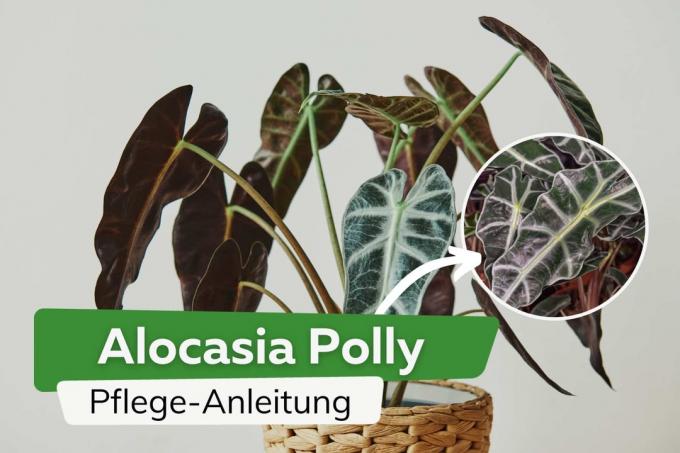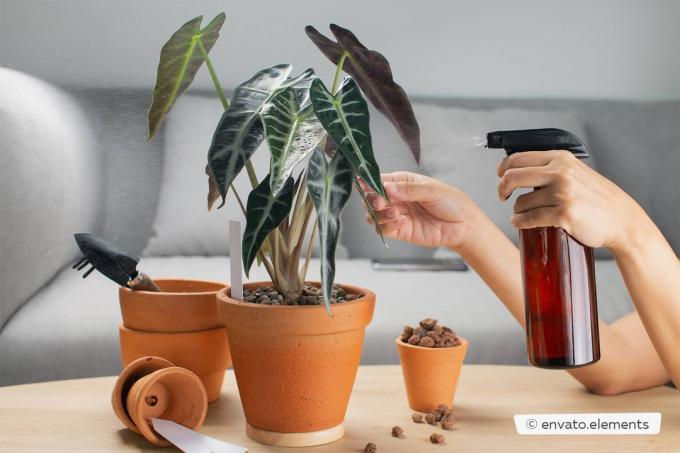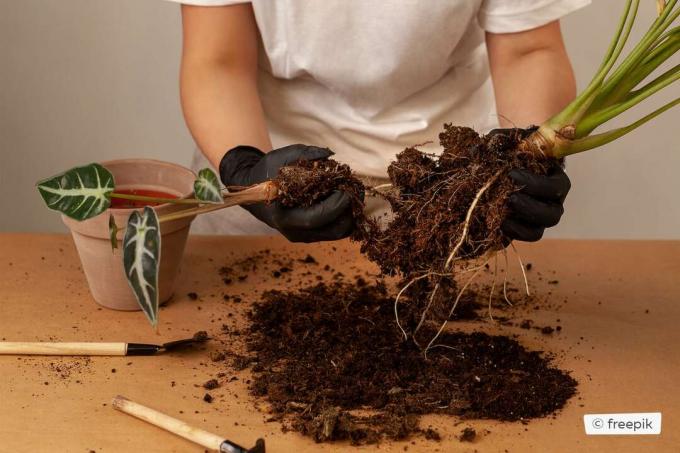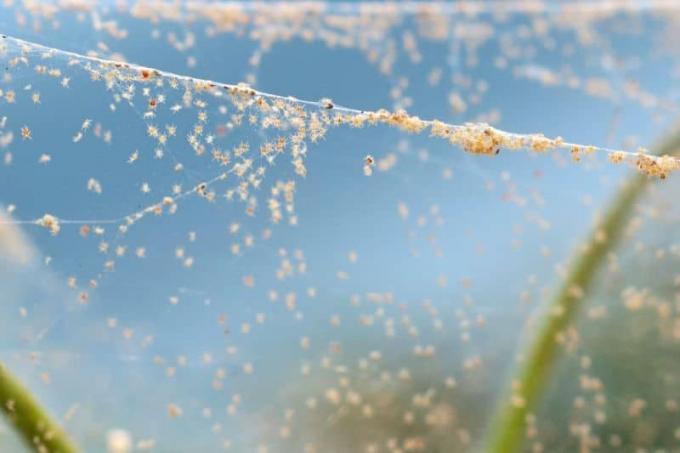
Profile and care information open +close -
- flower color
- white
- Location
- sundry
- growth habit
- erect, clump-forming
- Height
- 100cm
- soil type
- sandy, loamy
- soil moisture
- moderately moist
- PH value
- slightly sour
- lime tolerance
- Calcium intolerant
- humus
- rich in humus
- Poisonous
- Yes
- plant families
- Aroid family, Araceae
- plant species
- Indoor plants, balcony plants, potted plants
Its leaves are impressive: 40 cm long, dark green, leathery, arrow-shaped, with thin, wavy edges and, as if that alone is not enough, silver-colored leaf veins. Now only the care of the Alocasia "Polly" has to be right.
Table of contents
- Location
- substrate
- Pour
- Fertilize
- Cut
- repot
- propagation
- planting of tubers
- division of the rhizome
- Propagation by offshoots
- Diseases
- pests
- hibernate
- frequently asked Questions
Location
The Alocasia, or Alokasie, "Polly" feels at home as a houseplant in this country, but can spend the summer months outside. The temperature readings should be consistently between 18 and 28 °C. Even in winter or at night the temperature should not fall below 15 °C. Cold drafts also harm her. The plant with tropical origin should get a lot of light, but must not be reached directly by the sun. The humidity should be at least 60%, 70% is even better.

Tip: A spot close to an east or west window is a good choice for this hybrid.
substrate
The air around the roots must circulate and excess water must drain away promptly. To achieve this, you should buy a high-quality, coarser substrate, or mix sphagnum (peat moss) with expanded clay and sand.
Pour
This alocasia also loves moisture, so the root ball needs to be kept evenly moist or its beautiful appearance will suffer. To avoid waterlogging, only water again when the upper layer of soil, about 2-3 cm, has dried. The finger test helps to determine the right time for watering. Further points that are important for the water supply:
- water about 1-2 times a week
- Discard excess water as soon as possible
- use room temperature water
- it should be low in lime
- water more sparingly in winter
- Spray alocasia from time to time if the air in the room is dry

Tip: Do not plant the "polly" in a terracotta pot to avoid having to water it constantly. Because the storable material clay extracts a lot of water from the earth, which then evaporates over the outer surface of the pot.
Fertilize
From April to September, fertilize the arrow leaf every two weeks with a smaller portion of liquid fertilizer for green plants, which you apply over the irrigation water. Alternatively, you can also use a slow-release fertilizer. Immediately after purchase or after repotting, you should take a six-month fertilization break, since the fresh soil is usually sufficiently saturated with nutrients.
Cut
Cut? This beautiful plant must not lose a leaf! Because every single copy is a piece of jewellery. Cutting does not promote growth anyway. You should only remove diseased and dying leaves from the plant as soon as possible. So they can no longer extract energy from her. And she gets her flawless beauty back! The Alocasia "Polly" is also capable of forming white flowers. These are very inconspicuous and also poisonous. You should remove the flowers as soon as possible, as they rob the plant of a lot of strength.
Tip: Cover the open interface with some charcoal powder to prevent pathogens from entering.
repot
A planter that is too small and/or an exhausted substrate are a signal to repot the plant next spring, at the latest by the beginning of summer.

- repot about every two years
- choose a slightly larger pot (3-4 cm more circumference)
- large drainage holes are mandatory every time
- Shake off the old substrate completely from the root ball
- cut off dead and damaged roots
- water after repotting
propagation
The propagation of the Alocasia "Polly" is surprisingly easy. Because there are three ways of propagation at home that you can use. You can use tubers, divide the rhizome or use offshoots. Below you will find the most important information for all three methods.
planting of tubers
This propagation method is ideal if you have an older Alocasia "Polly". Because it is the older specimens that form tubers. You will find the not so small, elongated tubers between their roots. Therefore, repotting in the spring is a good opportunity to look for them. They should fill up tightly and not be too moist, then they are ideal for propagation. Separate the tubers from the mother plant to root them in moist sphagum moss. When they sprout, you can plant them properly.
division of the rhizome
Propagation by dividing a rhizome can ideally be done in spring when repotting. The alocasia that the rhizome supplies does not have to be old, but should have reached a sufficient size. Wear gloves because the sap can irritate the skin of sensitive people.

- Get the plant out of the pot
- get rid of soil
- disinfect a sharp knife
- Cut through the rhizome between two leaf nodes
- treat preventively with a fungicide
- alternatively sprinkle interfaces with charcoal
- Allow interfaces to dry
- then plant both parts separately
- leafless rhizome must not be completely covered by soil
The leafless piece of rhizome will sprout again from sleeping eyes. However, you should ensure tropical conditions until then. Consistently high humidity and temperatures around 25 °C are ideal.
Tip: Remove some leaves from the mother plant immediately after planting back, as the reduced rhizome can no longer provide the original supply. If you don't do this purposefully, it will soon have to shed some leaves on its own.
Propagation by offshoots
Small offshoots will eventually sprout from the tubers if they are not separated. Propagation with their help is very simple:
- Pot mother plant
- ideally combine with repotting
- Separate cuttings from mother plant
- plant in their own pots

The planted offshoots are cared for from the start like the adult mother plant.
Diseases
The Alocasia amazonica "Polly", as this ornamental leaf plant is often offered in the trade, rarely gets diseases, rather mistakes in care cause problems.
A small overview:
- yellow leaves: cold air or too little or too much water
- drooping leaves: too little light or low humidity
- brown leaf tips: humidity low, below 60%; over-fertilization or salt deposition
- rotting roots: cool temperatures; waterlogging
pests
The Alocasia is not so popular when it comes to pests. However, the dry heating air in winter can attract spider mites. Check your houseplant regularly and you won't miss the telltale cobwebs. With a small infestation, it is sufficient if you rinse off the arrowhead in the shower. Otherwise spray the plant with a neem oil based product or a mixture of water, curd soap and denatured alcohol. Predatory mites are natural enemies. Occasionally, mealybugs and scale insects can also occur, which you can combat with one of the many tried-and-tested home remedies. As long as the Alocasia "Polly" has not been completely freed from all pests, you should isolate it from healthy plants.

hibernate
Of course, your Alocasia “Polly” has to spend the winter indoors. It is not fertilized during the winter months, or at most once a month. Since it does not grow as much in the darker season or less moisture evaporates, it is also watered less. There is no need to put them cooler. On the contrary, it can harm her. Because temperatures below 13 °C can lead to leaf shedding.
frequently asked Questions
Adult specimens can keep their pot if it holds about 20 liters. However, this does not apply to the leached substrate. You should continue to renew this regularly in the spring.
Flush the substrate for about five minutes every 6 months. As a result, many salts are washed out and their concentration in the soil decreases significantly.
Her "Polly" is probably much too dark and therefore suffers from a lack of light. Give it a brighter spot as soon as possible. However, make sure that she continues to only get indirect light. Sunshine can quickly burn her leaves.
Yes, the plant is poisonous to our pets too. Since she certainly attracts the attention of the animals due to her striking appearance, it is better not to meet the two. In concrete terms, this means: for the sake of your animals, do without alocasia altogether. Or, if the opportunity arises, take them with you to the office.
Tubers from different Alocasia species are offered on the market. The hybrid Polly is not likely to be found among them. That may change in the near future.



